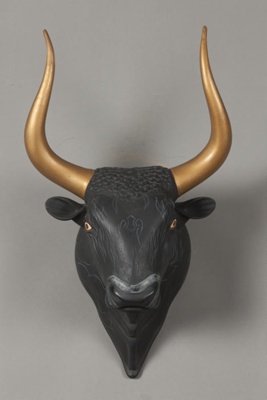< Collection search
< Collection highlights
From:UC Teece Museum of Classical Antiquities
Name/TitleMinoan Rhyton
About this objectOne of the two great cultures that flourished in Bronze Age Greece is the Minoan civilisation, based on the island of Crete. Despite flourishing for many hundreds of years between around 3000 BCE to 1100 BCE, the Minoan culture suddenly disappeared and was almost unknown for centuries, except for references to it in Greek mythology.
Sacrifice was an important ritual within the Minoan religion. Images found on frescoes and seals often depict the bull as the most powerful and impressive of animals. This is a plaster cast of a spectacular Minoan rhyton in the shape of a bull’s head. The original would have been used for pouring sacrificial offerings (libations) during a religious ceremony.
The original rhyton is made of steatite, and the snout is outlined with an inlay of white seashell, while the preserved right eye is inlaid with rock crystal, with rim and iris of red jasper. Horns originally gilded wood. It was found in a pillar crypt (a room with a central pillar) within the Little Palace of Knossos, and is dated to 1500–1400 BCE.
The rhyton may have held the blood of a sacrificial animal, indicated on the original by a hole in the neck for filling and a hole in the neck for pouring, and its use can be seen as a metaphor for the ritual re-enactment of the bloodletting that began the sacrifice.
MakerMinistry of Culture Archaeological Receipts Fund
Maker RoleCasting and Copying Workshop
Date Madeca. 1988-1989 AD
PeriodLate Minoan II
Place MadeGreece; Athens
Place NotesOriginal manufactured in Knossos
Medium and MaterialsPlaster
Style and IconographyMinoan
TechniqueCasting (process)
MeasurementsHeight 450 mm
Weight 3040 gm
Named CollectionThe James Logie Memorial Collection, University of Canterbury, New Zealand
Credit LinePurchased, 1979.
Object TypeLibation vessels
Object numberCC4
Copyright LicenceAll rights reserved
